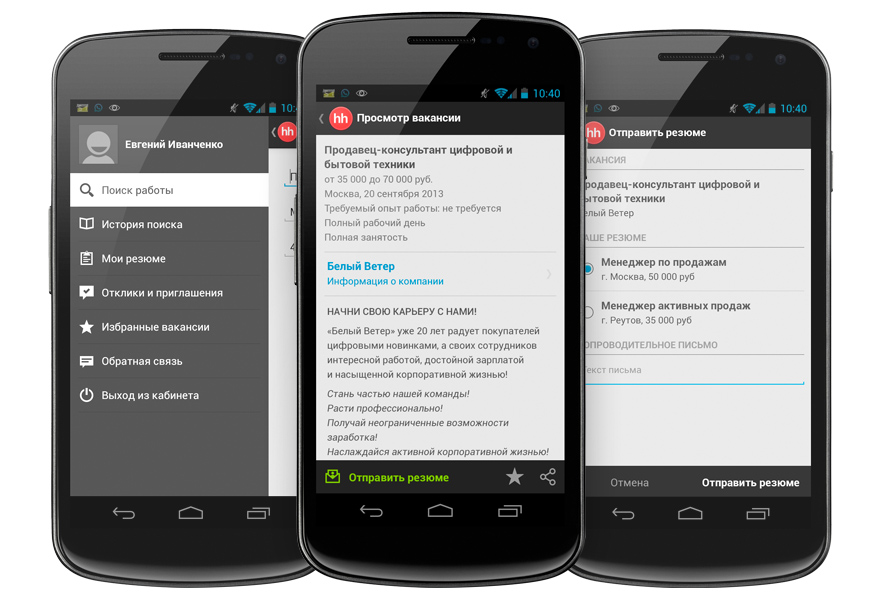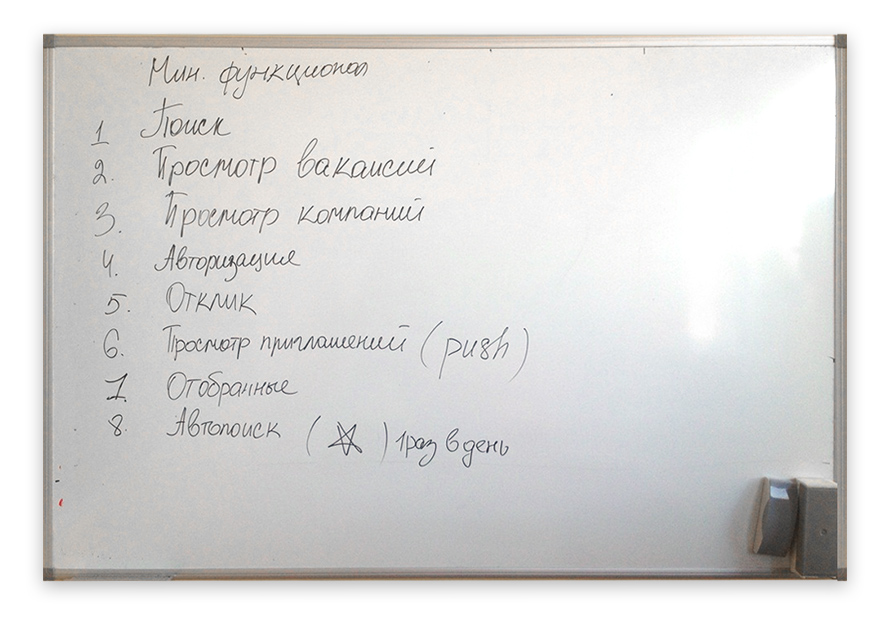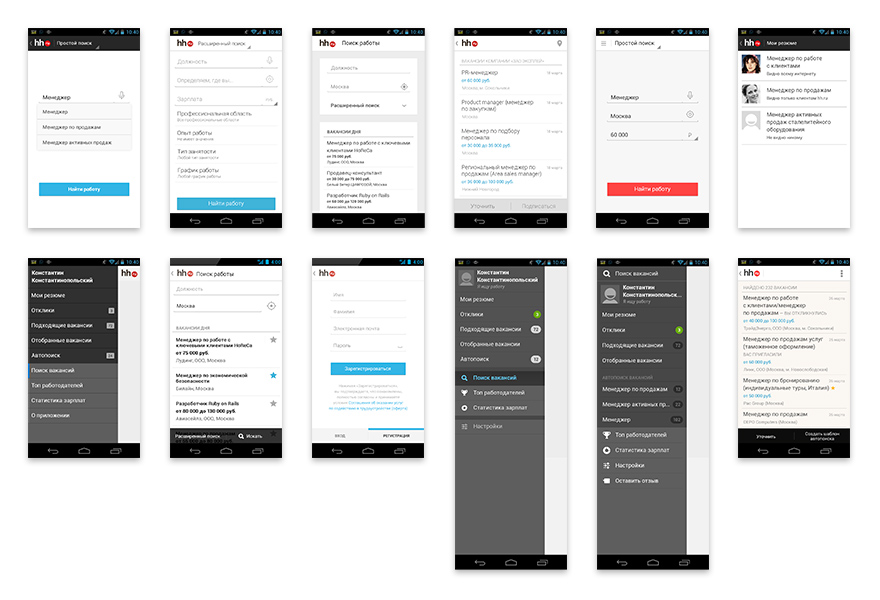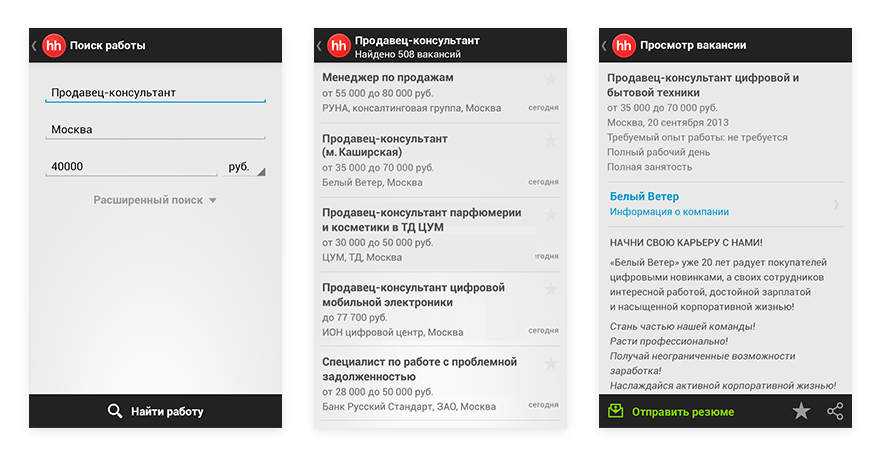HeadHunter on Android: finally!
We recently released an Android app. The first version has basic functionality - now it is just convenient to look for work in it, responding to your favorite vacancies, but in the next releases the opportunities will expand. The main thing is that HeadHunter finally has an application with demanded features, which we will now develop. It is available for installation on Google Play.
In this article I would like to share with you our application development history.

In February this year, hh.ru mobile traffic accounted for about 5.5% of the total, and in August it grew to 7.8%. In absolute terms, this means that about one and a half million people came to us from one or another mobile device. At the same time, the share of gadgets on Android is from 30 to 40%. With such growth rates, by the beginning of next year every tenth hh.ru user will be “mobile”. So, he will need a convenient and fast interface that allows you to do on the mobile device all the same that he used to do on a regular site.
Last year, we already released apps for iOS and Windows Phone. Their external contractors were developing, and the Android version was already made by our own team of four people (designer, developer, tester and leader), which we formed to continue the development of mobile applications for all popular platforms. Now this is one of the priority areas of work in the company.
When we were just beginning to develop an Android application, the team working on the mobile direction within the company did not exist, it was only to be created. Therefore, we gathered an initiative group and prepared the first “road map”.
Strategically, this plan has not changed much until now, and now we continue to adhere to it, having refused only auto searches for the first public release.

The recruitment phase was not as fast as we wanted. In particular, at that time in our team there was no interface specialist. Therefore, it was decided to use the experience of flexible development methods in order to begin to obtain intermediate results with so far limited human resources. We began to formulate requirements for the application interface practically from scratch, using a modification of the Wizard of Oz practice to build the interface layout . Despite the fact that we already had experience with applications, we wanted to at least check them for relevance, and preferably improve them.
The work was structured as follows: a hand-drawn prototype of the interface was prepared. He was shown to test participants, watching their reaction and expectations when changing the interface. During the experiment, only the test subject spoke, voicing his actions or expectations. If the next screen of the interface did not meet his expectations, then we would redraw or redraw it right on the go. As a result, we got a prototype interface that has already passed the first user suitability test and is ready to set up a work task for a designer and developer.

I must say that the designer in the team appeared later than the developer, so we started developing the functionality and development according to the requirements of paper prototypes. At first, the application looked like this:

We stopped at the step when, with the help of simple visual means, the limit of the transmitted sense was reached. The basic requirements have been clarified. With the inclusion of the designer, the work went more fun, he continued to work on the interface:

Prior to the start of public alpha testing, we tested the paper-based interface on real users. This is a variant of the Wizard of Oz, but with more elaborate layouts. I must say that “paper testing” is not a very convenient option for testing the mobile interface, because with ready-made images you want more interactivity than games with pieces of paper. However, this stage allowed us to test some of the hypotheses. For example, at first we wanted to greatly reduce the number of search parameters (search fields), but in the end, thanks to testing, we left the possibility of an advanced search.

When the first more or less stable version was ready, it was necessary to start testing it in the field. To do this, we took advantage of the ability of Google Play to do alpha releases and distribute them through private groups on Google+. Having assembled even a small group for alpha testing, we got valuable feedback. We have already implemented most of the wishes of the testers.
As a result, we got a solid basic application with which you can:

On the day the final version is released, we have already begun work on the following versions, which will add the following functions in the near future:
In addition, each next version will necessarily contain small new features and improvements, because everything is in the details.
We also hope for a quick strengthening of our team - this year a separate set for mobile development was made at the HeadHunter programmer’s school .
UPD: You can install the application on Google Play:


In this article I would like to share with you our application development history.

Why do we need applications and who makes them
In February this year, hh.ru mobile traffic accounted for about 5.5% of the total, and in August it grew to 7.8%. In absolute terms, this means that about one and a half million people came to us from one or another mobile device. At the same time, the share of gadgets on Android is from 30 to 40%. With such growth rates, by the beginning of next year every tenth hh.ru user will be “mobile”. So, he will need a convenient and fast interface that allows you to do on the mobile device all the same that he used to do on a regular site.
Last year, we already released apps for iOS and Windows Phone. Their external contractors were developing, and the Android version was already made by our own team of four people (designer, developer, tester and leader), which we formed to continue the development of mobile applications for all popular platforms. Now this is one of the priority areas of work in the company.
Process of creation
When we were just beginning to develop an Android application, the team working on the mobile direction within the company did not exist, it was only to be created. Therefore, we gathered an initiative group and prepared the first “road map”.
- The minimum volume of a viable product (MVP - Minimal Viable Product) which includes functions that allow you to complete a full cycle of job search. This is the search and viewing of vacancies, viewing companies, responding to vacancies, viewing responses and invitations, push notifications about invitations, adding vacancies to favorites, auto search.
- Product goals. Until the end of the year, this is an MVP release.
- Risks They were of two types: internal resource and external in the form of negative assessments. Globally, there were practically no risks, since we are making a free application of the most popular job search service in Russia, and it will be in demand.
Strategically, this plan has not changed much until now, and now we continue to adhere to it, having refused only auto searches for the first public release.

The recruitment phase was not as fast as we wanted. In particular, at that time in our team there was no interface specialist. Therefore, it was decided to use the experience of flexible development methods in order to begin to obtain intermediate results with so far limited human resources. We began to formulate requirements for the application interface practically from scratch, using a modification of the Wizard of Oz practice to build the interface layout . Despite the fact that we already had experience with applications, we wanted to at least check them for relevance, and preferably improve them.
The work was structured as follows: a hand-drawn prototype of the interface was prepared. He was shown to test participants, watching their reaction and expectations when changing the interface. During the experiment, only the test subject spoke, voicing his actions or expectations. If the next screen of the interface did not meet his expectations, then we would redraw or redraw it right on the go. As a result, we got a prototype interface that has already passed the first user suitability test and is ready to set up a work task for a designer and developer.

I must say that the designer in the team appeared later than the developer, so we started developing the functionality and development according to the requirements of paper prototypes. At first, the application looked like this:

We stopped at the step when, with the help of simple visual means, the limit of the transmitted sense was reached. The basic requirements have been clarified. With the inclusion of the designer, the work went more fun, he continued to work on the interface:

Prior to the start of public alpha testing, we tested the paper-based interface on real users. This is a variant of the Wizard of Oz, but with more elaborate layouts. I must say that “paper testing” is not a very convenient option for testing the mobile interface, because with ready-made images you want more interactivity than games with pieces of paper. However, this stage allowed us to test some of the hypotheses. For example, at first we wanted to greatly reduce the number of search parameters (search fields), but in the end, thanks to testing, we left the possibility of an advanced search.

When the first more or less stable version was ready, it was necessary to start testing it in the field. To do this, we took advantage of the ability of Google Play to do alpha releases and distribute them through private groups on Google+. Having assembled even a small group for alpha testing, we got valuable feedback. We have already implemented most of the wishes of the testers.
Result
As a result, we got a solid basic application with which you can:
- pick up interesting vacancies;
- send feedback on vacancies using your resume created on hh.ru;
- add vacancies to “favorites” to respond to them later;
- Receive push notifications about an invitation to an interview from employers;
- view a list of your resumes;
- View responses, invitations and their status.

Development plans
On the day the final version is released, we have already begun work on the following versions, which will add the following functions in the near future:
- editing resumes. We are still skeptical that a good resume can be created on the phone from scratch, simply because typing voluminous text on the phone is an occupation for an amateur. In addition, it is important for employers to have a well-filled resume, and the phone does not contribute to thorough filling. But it’s quite possible to correct the existing one, it is a fact;
- subscription to search results for vacancies with the desired parameters;
- work with data offline;
- view vacancies on the map.
In addition, each next version will necessarily contain small new features and improvements, because everything is in the details.
We also hope for a quick strengthening of our team - this year a separate set for mobile development was made at the HeadHunter programmer’s school .
UPD: You can install the application on Google Play:


